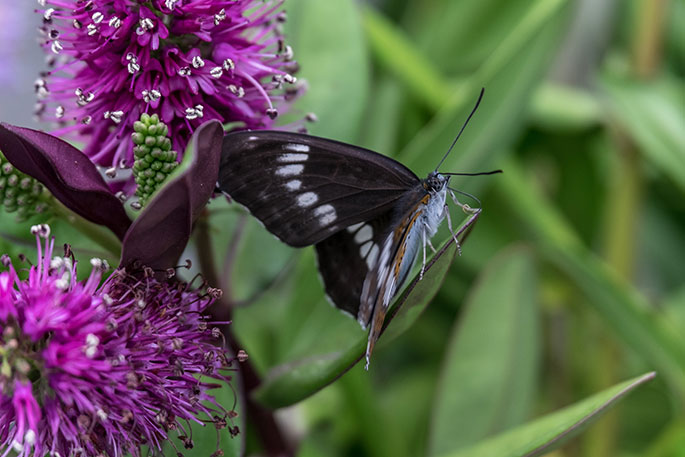In the fight against an aggressive vine invading New Zealand, Manaaki Whenua – Landcare Research scientists are sending an army of caterpillars to the battlefield.
For the first time in New Zealand, hundreds of Japan's Honshu white admiral butterflies have been successfully reared as a biocontrol agent for the widespread vine known as Japanese honeysuckle.
This is an amazing milestone for Biocontrol scientists Hugh Gourlay and Quentin Paynter, in battle against the rapid-growing vine invading the country's native bush, roadsides, and wastelands.
'It is a very significant step for us,” says Hugh, 'Japanese honeysuckle is a really big problem. We've got several regional councils who have a problem with it and are keen to get hold of our biocontrol agents.”
The sweet-smelling, flowering evergreen vine is very common across New Zealand. A tough and resilient plant, it spreads quickly, climbing over and suffocating plants.
It was first introduced as an ornamental hedging plant from Japan in 1872, but by 1926 it was reported to have started spreading and growing in the wild.
In 2013, scientists were approved by the EPA to release the butterflies in New Zealand, and a year later they attempted to use the Japanese butterfly's caterpillars as a bio-control method for the weed; releasing a small number at Karangahake Gorge in the Waikato.
From there, they began successfully rearing the butterflies in shade houses at Manaaki Whenua's Auckland and Lincoln sites.
'The rearing has been very successful. It's the first time we have had vast numbers of caterpillars consuming our plants,” says Hugh.
Butterflies are often fussy when it comes to the conditions in which they will mate.
Quentin says they spent three years trying to hand pair them in containment facilities.
'We then tried to get the butterflies to mate and lay eggs by releasing them into the Butterfly Creek butterfly house and that didn't work either.
'So eventually we imported mated adult butterflies collected from the field in Japan, reared their eggs through to the adult stage and then trial released them in New Zealand. They became established and were then collected from the release site where we were delighted to find that their offspring displayed normal mating behaviour in our shade houses, enabling mass-rearing,” says Quentin.
The reared butterflies are now laying thousands of eggs, which will be released as caterpillars at nine Japanese honeysuckle-infested sites in the North and South Island.
To ensure a good establishment, Hugh says they aim to release at least a thousand caterpillars at each of the release sites around the country – which means rearing large numbers of caterpillars.
Scientists will continue breeding the butterflies, and expect it will take around five to 10 years to see a wide-scale impact.
'It's also a very long-term process. So it's not something where you can put an agent out or an insect out and see the weed disappear because that's never going to happen. This is about controlling the weed, reducing its presence in our environment. That's the aim and those things often take quite a while to achieve,” says Hugh.



1 comment
Beauty or the beast
Posted on 30-01-2018 08:34 | By maybelle
Surely a lovely looking butterfly, I am just wondering if the Japanese honeysuckle is the only plant they eat .....
Leave a Comment
You must be logged in to make a comment.